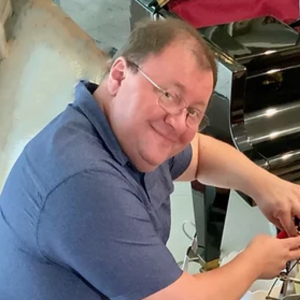What exactly does it entail?

The pedals connect to rods that run through the column, where they connect with the action—a system of links, arms, and spindles that turn each disc. The links are fastened together by steel rivets, which are hand fit and tightened when the harp is made. Over time and with use, the rivets are squeezed by the force of the action’s motion and become misshapen. When this happens, the harpist will begin to hear knocking or clicking sounds when moving the pedals. These noises may become louder with time and use. As rivets wear, the links can become loose, and may start to rattle and vibrate sympathetically with specific notes on the instrument. If tapping on the back plate of the mechanism with the heel of your hand produces a lot of rattling noises, then some of the links are loose. The solution is to completely disassemble the action and replace each of these hundreds of rivets, again by hand. That is what a re-riveting job entails.
When the pedal noises and sympathetic vibrations get so loud and intrusive that they detract from the music being played, it’s time to think about re-riveting. It is fairly rare for worn out rivets to actually fail, so this is more of a noise problem than a structural one. Actions that need re-riveting don’t tend to stop working entirely; they just get louder and more annoying.
—Steve Moss

Your harp will let you know when it’s time to consider re-riveting. When you start hearing clicking noise in the action while moving the pedals, it may be a sign that the rivets connecting arms and links are wearing out and may need re-riveting. This doesn’t mean the action is falling apart, and you may continue using the harp. However, with time, the clicks will become louder and more noticeable, and may interfere with performing or recording music.
Having the harp re-riveted entails shipping the instrument to the factory, where the action will be taken apart and all rivets replaced with new ones.
—Joe Urban

When you can no longer put up with the noise. Imagine riding on a roller coaster—flying up and down at high speed being thrown against riders and harnesses. You hit a wall at full speed, dead stop. C is now in natural. Zero to 60 and smack into a wall. Let’s do that again! This is a rivet’s life. Many rivets inside the action are about half the diameter of a grain of rice and they take this violence over and over and over. For them, it is not a fun ride.
More pedaling means more wear. This wear eventually leads to noise. When you pedal, and it sounds like nasty elves are rapping inside with hammers, it might be time. In the later stage, there will be sizzles or buzzing from the links inside the action. The connections of the rivets, links, and arms have loosened to the point where they freely vibrate with the music. At the end stage, every time you play the strings you “play” the links as well. Actions always make some amount of noise. The big question is “can the audience hear it?”
The re-riveting repair involves not only the rivets, but the links, arms, and blocks as well. To achieve a high-quality repair, some parts will need to be outright replaced, which is why this must be done at the factory. •






